Is the Painted Lady a Moth or a Butterfly?
The Painted Lady (Vanessa cardui) is definitively a butterfly, not a moth. It exhibits diurnal behavior and possesses vibrant wing patterns along with club-shaped antennae, characteristic of butterflies.
Its life cycle includes a distinctive chrysalis stage. Physically, Painted Ladies have slender wings and bodies, contrasting with the broader wings and robust bodies of moths.
Genetic and environmental factors influence their vivid coloration and wing morphology, aiding in camouflage and mating. These butterflies are globally distributed, except in Antarctica, and have notable migratory behaviors.
Understanding these traits provides an extensive view of their classification and ecological role.
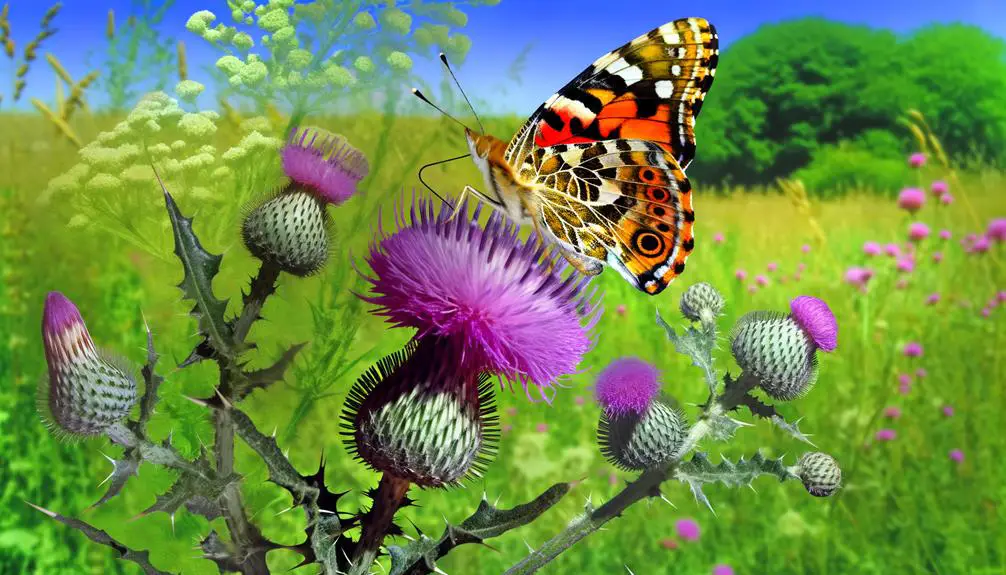
Key Takeaways
- Painted Lady is classified as a butterfly due to its diurnal activity and vibrant wing patterns.
- Club-shaped antennae and slender wings distinguish Painted Lady butterflies from moths.
- Painted Lady butterflies undergo a chrysalis stage, typical of butterflies.
- They thrive globally in diverse habitats, excluding Antarctica.
Butterfly or Moth?
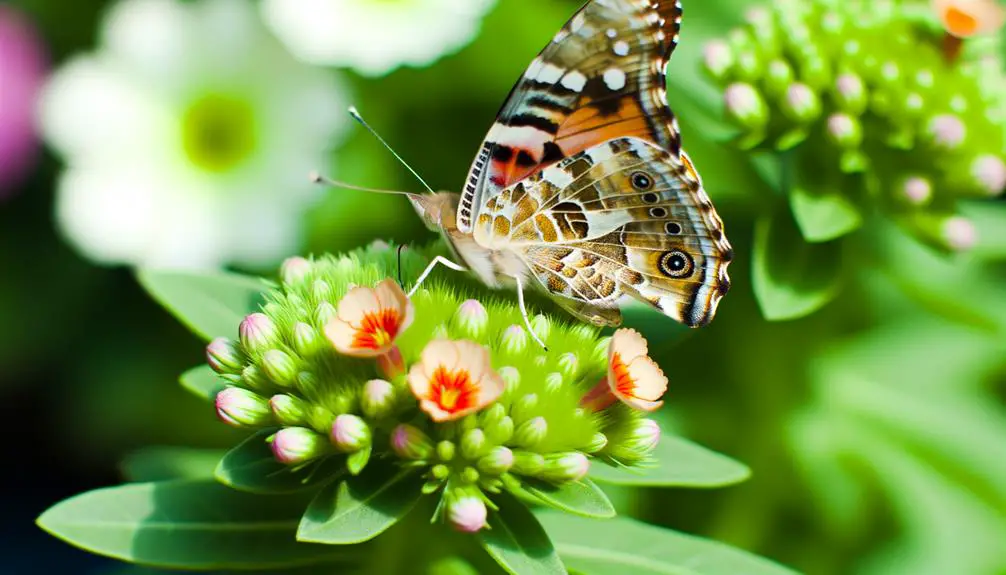
The Painted Lady, belonging to the genus Vanessa, is primarily recognized as a butterfly rather than a moth, distinguished by its diurnal activity and vibrant wing patterns.
Unlike moths, which are typically nocturnal, Painted Ladies are active during the day, engaging in behaviors such as nectaring and basking. Their antennae are club-shaped, a characteristic feature of butterflies, contrasting the feathery or filamentous antennae seen in moths.
Additionally, Painted Ladies undergo a chrysalis stage rather than forming a cocoon, aligning them with butterfly metamorphosis processes. These distinctions emphasize the classification of the Painted Lady as a butterfly, allowing for a more precise understanding of its biological and ecological roles.
Such clarity empowers those with a passion for nature to appreciate its nuanced diversity.
Physical Characteristics
The physical characteristics of the Painted Lady, whether classified as a moth or butterfly, are marked by distinct wing patterns and notable differences in size and shape. These wing patterns typically feature vibrant orange and black hues with intricate white spots on the tips. Additionally, variations in size can be observed depending on environmental factors and geographic location. Observing painted lady butterfly egg signs on host plants can provide insight into their early development stages before they transform into caterpillars.
The intricate and vibrant coloration on their wings serves as a primary identification marker, aiding in the differentiation between related species.
Additionally, variations in wing morphology contribute to their aerodynamic capabilities and overall appearance.
Wing Pattern Differences
Wing pattern differences between the painted lady moth and butterfly are primarily characterized by distinct variations in coloration, shape, and arrangement of scales.
Painted lady butterflies exhibit vibrant, intricate patterns with orange, black, and white hues, often featuring symmetrically arranged spots and wavy lines. The scales on their wings are densely packed, creating a vivid mosaic of colors.
In contrast, painted lady moths possess more muted, earthy tones, with less pronounced patterns that serve as camouflage. Their wing scales are often spaced differently, leading to a subtler visual texture.
These differences are essential for adaptive survival strategies, aiding butterflies in attracting mates and deterring predators, while moths benefit from blending into their surroundings during the day.
Size and Shape
Characterized by distinct differences in their physical dimensions and contours, painted lady butterflies typically feature a more elongated and slender wing structure, whereas painted lady moths exhibit broader and more robust wings.
The wingspan of painted lady butterflies generally ranges from 5 to 9 centimeters, displaying a delicate, aerodynamic form suited for extensive travel and efficient flight. In contrast, painted lady moths possess a more expansive wingspan, often exceeding 10 centimeters, with a denser composition that enhances their resilience.
Additionally, the body morphology of butterflies is comparatively slimmer and more tapering, aiding their agile navigation. Moths, however, have more substantial bodies, contributing to their durable yet less graceful flight patterns.
These physical traits underscore the evolutionary adaptations specific to their respective ecological niches.
Wing Patterns
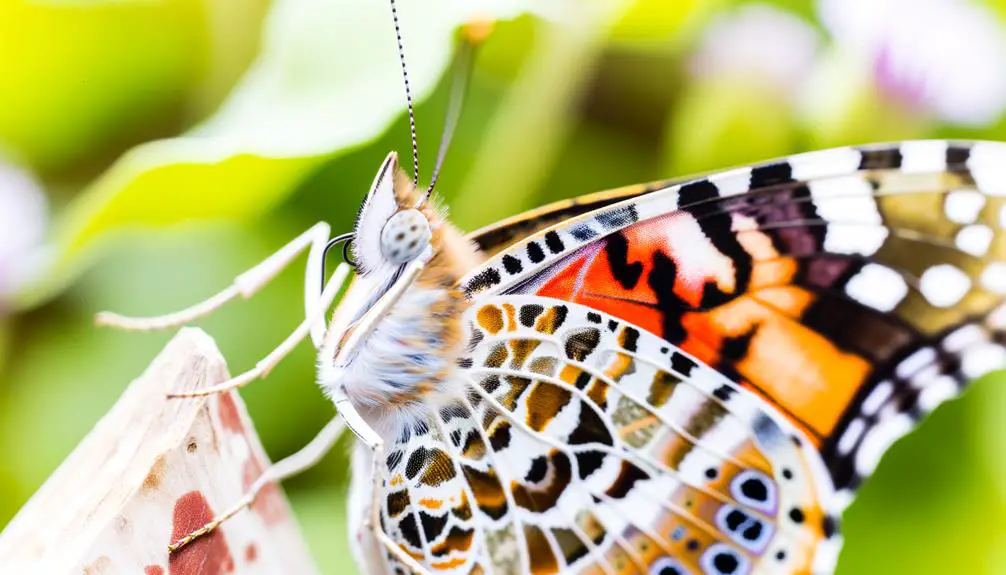
The wing patterns of Painted Lady butterflies and moths exhibit significant color variations, ranging from vibrant oranges and pinks to more subdued browns and grays.
These patterns often display remarkable symmetry, which plays a vital role in species identification and camouflage.
Analyzing these characteristics provides insight into their evolutionary adaptations and ecological interactions.
Color Variations
Despite their common name, Painted Lady moths and butterflies exhibit a remarkable array of color variations and intricate wing patterns that serve both aesthetic and functional purposes. These variations are influenced by genetic, environmental, and developmental factors.
The following key aspects illustrate the diversity and significance of these patterns:
- Genetic Diversity: Genetic variations result in different color morphs, affecting the hue and intensity of the wing patterns.
- Environmental Impact: Temperature, humidity, and diet during the larval stage can alter pigmentation, leading to seasonal morphs.
- Adaptation Mechanisms: Wing patterns play vital roles in camouflage, mimicry, and mate selection, enhancing survival and reproductive success.
These elements underscore the complexity and adaptive significance of the Painted Lady's wing coloration.
Pattern Symmetry
Intricate and balanced, the pattern symmetry of Painted Lady moths and butterflies is a product of complex developmental processes that guarantee mirror-like precision across their wings. This bilateral symmetry is orchestrated by the expression of specific genes during the pupal stage, directing pigment distribution and scale formation.
The resultant wing patterns serve not only an aesthetic function but also provide crucial camouflage and signaling mechanisms. Each wing's left and right sides exhibit nearly identical arrangements, enhancing aerodynamic efficiency and predator evasion.
The meticulous alignment of spots, stripes, and hues across the wings underscores the evolutionary advantages of such symmetry, illustrating a fine-tuned interplay between genetics, environmental pressures, and adaptive functionality, essential for survival and reproductive success.
Life Cycle Stages
Beginning with the egg stage, the life cycle of the Painted Lady, scientifically known as Vanessa cardui, progresses through a series of well-defined stages that include larva, pupa, and adult. This metamorphosis is critical for its survival and adaptation.
- Egg: Eggs are laid singly on host plants and hatch within 3-5 days, depending on environmental conditions.
- Larva: The larval stage, or caterpillar, lasts about 10-14 days, during which the organism undergoes five instars, growing rapidly as it feeds on host plants.
- Pupa: The pupal stage, or chrysalis, lasts approximately 7-10 days. During this period, metamorphosis occurs, transforming the larva into a mature adult butterfly.
These stages collectively guarantee the Painted Lady's successful development and reproduction.
Habitat and Range
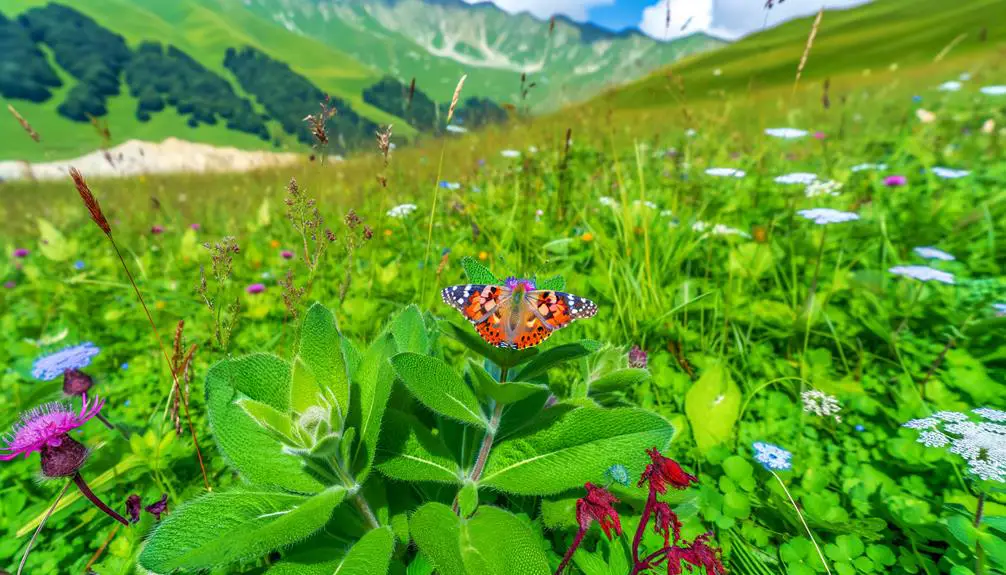
The Painted Lady butterfly, Vanessa cardui, exhibits a remarkable adaptability, inhabiting a wide range of environments from temperate regions to tropical areas across all continents except Antarctica.
This species thrives in diverse habitats such as grasslands, gardens, meadows, and even arid deserts. Its distribution is facilitated by strong migratory behavior, enabling it to colonize new territories rapidly.
The capacity to endure various climatic conditions—from the cooler temperate zones to the warmer tropics—demonstrates its resilience.
Significantly, the Painted Lady is capable of long-distance migrations, sometimes covering thousands of kilometers, which guarantees genetic diversity and population stability.
Their presence in such varied ecosystems underscores their biological versatility and emphasizes their broad ecological niche.
Feeding Habits
Painted Lady butterflies exhibit a diverse range of feeding habits, primarily engaging in nectar consumption from various flowering plants, which provides essential nutrients for their survival and reproduction.
These butterflies demonstrate a preference for a wide variety of floral sources, exhibiting adaptability in their foraging behavior.
Key feeding habits include:
- Nectar Feeding: They rely heavily on nectar from flowers such as thistles, asters, and milkweed, ensuring a rich intake of sugars and amino acids.
- Mud-puddling: Males often engage in mud-puddling, where they extract minerals and salts from moist soil or puddles, vital for reproductive success.
- Sap and Honeydew: In times of floral scarcity, they may supplement their diet with tree sap and aphid honeydew, demonstrating their dietary flexibility.
Migration Journey
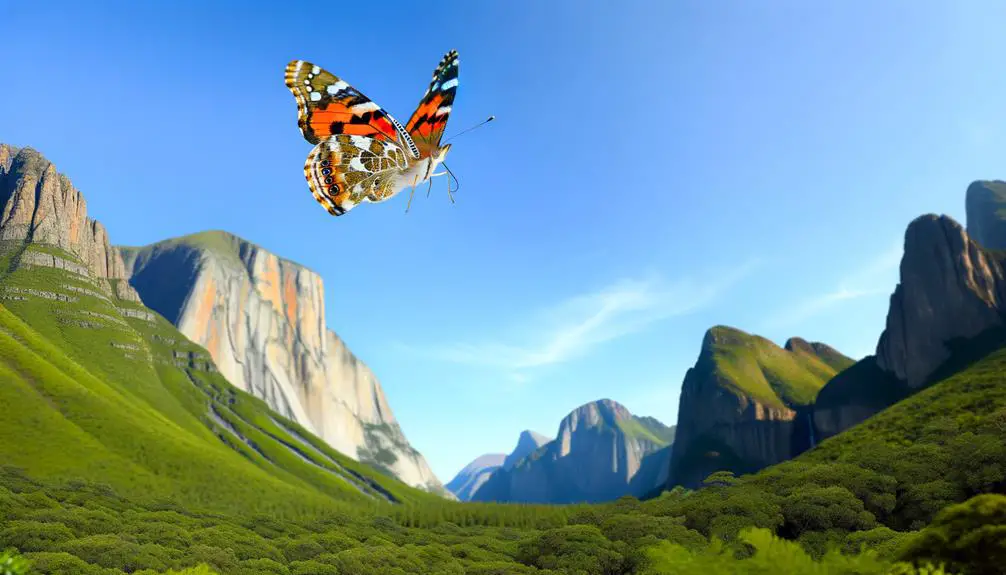
Unlike many butterflies, the migratory behavior of the Painted Lady involves long-distance travel that spans multiple generations, making it a fascinating subject of study in lepidopterology.
These butterflies undertake an arduous journey, covering distances up to 9,000 miles in a single migratory cycle. Originating from North Africa and the Mediterranean, they traverse the Sahara Desert, reaching as far as Northern Europe.
This migration is not completed by a single individual but rather successive generations, each flying a portion of the route.
Environmental cues such as temperature and daylight length trigger these movements, ensuring survival and reproduction.
The Painted Lady's resilience and adaptability to diverse climatic conditions highlight its evolutionary success in steering through such extensive migratory paths.
Common Misconceptions
Despite their widespread recognition, several common misconceptions about Painted Lady butterflies persist, often stemming from a lack of thorough understanding of their complex life cycle and migratory patterns. These misconceptions can obscure the true nature of these fascinating insects.
A few prevalent misunderstandings include:
- Confusion with Moths: Painted Ladies are frequently mistaken for moths due to their similar size and wing patterns, despite being true butterflies.
- Limited Range: Many believe Painted Ladies are limited to specific regions, but they are actually found on every continent except Antarctica.
- Non-Migratory: Contrary to the belief that they are stationary, Painted Lady butterflies undertake extensive migratory journeys, sometimes traveling thousands of miles.
Conservation Efforts
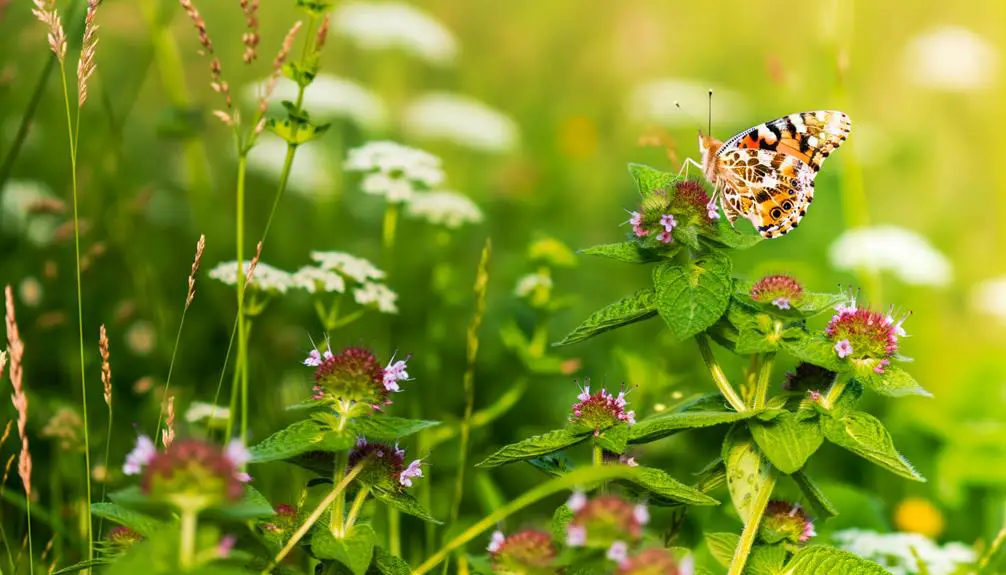
Effective conservation efforts for Painted Lady butterflies are vital to preserving their populations and maintaining the ecological balance they contribute to through pollination and as a food source for other species.
Strategies include habitat restoration, which involves planting native flora to provide important nectar sources and host plants for larvae.
Monitoring populations through citizen science initiatives allows for data collection on migratory patterns and population health.
Reducing pesticide usage is imperative, as chemical exposure can be detrimental to butterflies at various life stages.
Additionally, climate change mitigation efforts are necessary, as shifting weather patterns can disrupt migratory routes and breeding cycles.
These multifaceted approaches guarantee the survival of Painted Lady butterflies, thereby supporting biodiversity and ecosystem resilience.
Conclusion
The distinction between the painted lady butterfly and moth hinges on physical characteristics, wing patterns, and life cycles.
Understanding their habitat, feeding habits, and migration provides insight into their ecological roles. For instance, the painted lady butterfly's remarkable migration from North Africa to Europe exemplifies the complexity and endurance of these insects.
Addressing common misconceptions and promoting conservation efforts are essential for sustaining their populations and maintaining biodiversity.
Extensive study and preservation strategies are imperative for their continued survival.

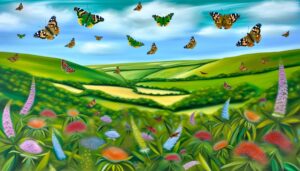
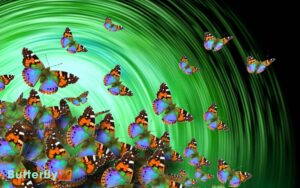
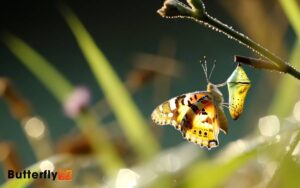

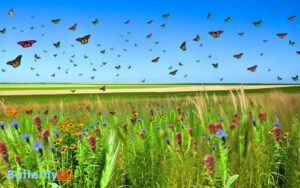
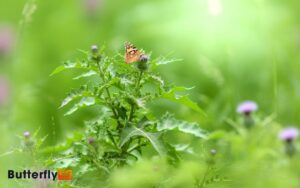
tvf8ev
Its great as your other articles : D, thankyou for posting.
https://www.zoritolerimol.com